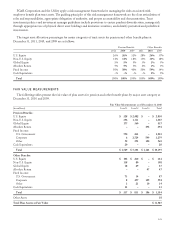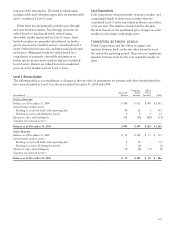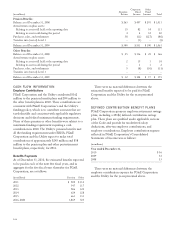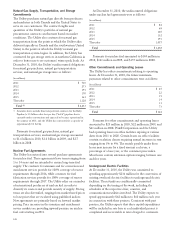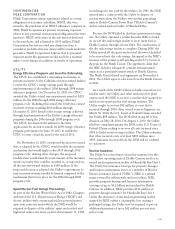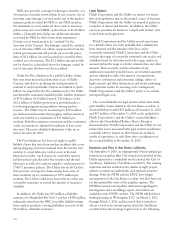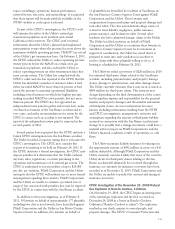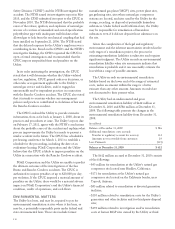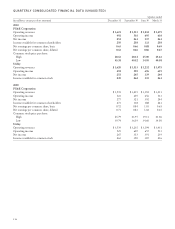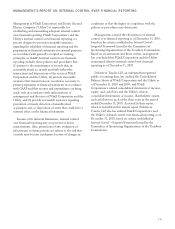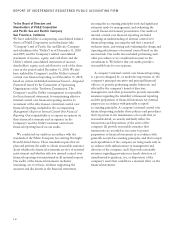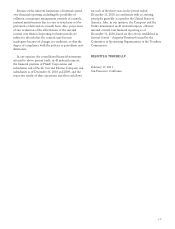PG&E 2010 Annual Report Download - page 113
Download and view the complete annual report
Please find page 113 of the 2010 PG&E annual report below. You can navigate through the pages in the report by either clicking on the pages listed below, or by using the keyword search tool below to find specific information within the annual report.CONTINGENCIES
PG&E CORPORATION
PG&E Corporation retains a guarantee related to certain
obligations of its former subsidiary, NEGT, that were
issued to the purchaser of an NEGT subsidiary company in
2000. PG&E Corporation’s primary remaining exposure
relates to any potential environmental obligations that were
known to NEGT at the time of the sale but not disclosed
to the purchaser, and is limited to $150 million. PG&E
Corporation has not received any claims nor does it
consider it probable that any claims will be made under the
guarantee. PG&E Corporation believes that its potential
exposure under this guarantee would not have a material
impact on its financial condition or results of operations.
UTILITY
Energy Efficiency Programs andIncentive Ratemaking
The CPUC has established a ratemaking mechanism to
provide incentives to the California investor-owned utilities
to meet the CPUC’s energy savings goals through
implementation of the utilities’ 2006 through 2008 energy
efficiency programs. On December 16, 2010, the CPUC
awarded the Utility a final true-up payment award of $29.1
million for the 2006 through 2008 energy efficiency
program cycle. Including this award, the Utility has earned
incentive revenues totaling $104 million through
December 31, 2010 based on the energy savings achieved
through implementation of the Utility’s energy efficiency
programs during the 2006 through 2008 program cycle.
The CPUC has directed the utilities to file their
applications for incentive awards for 2009 energy efficiency
program performance by June 30, 2011 to enable the
CPUC to issue a final decision by the end of 2011.
On November 15, 2010, a proposed decision was issued
that, if adopted by the CPUC, would modify the incentive
mechanism that would apply to the 2010 through 2012
program cycle. Among other changes, the proposed
modification would limit the total amount of the incentive
award or penalty that could be awarded to, or imposed on,
all the investor-owned utilities to $189 million. If the
proposed decision is adopted, the Utility’s opportunity to
earn incentive revenues would be limited compared to the
mechanism that was in place for the 2006 through 2008
program cycle.
Spent NuclearFuel Storage Proceedings
As part of the Nuclear Waste Policy Act of 1982, Congress
authorized the U.S. Department of Energy (“DOE”) and
electric utilities with commercial nuclear power plants to
enter into contracts under which the DOE would be
required to dispose of the utilities’ spent nuclear fuel and
high-level radioactive waste no later than January 31, 1998,
in exchange for fees paid by the utilities. In 1983, the DOE
entered into a contract with the Utility to dispose of
nuclear waste from the Utility’s two nuclear generating
units at Diablo Canyon Power Plant (“Diablo Canyon”)
and its retired nuclear facility at Humboldt Bay.
Because the DOE failed to develop a permanent storage
site, the Utility obtained a permit from the NRC to build
an on-site dry cask storage facility to store spent fuel at
Diablo Canyon through at least 2024. The construction of
the dry cask storage facility is complete. During 2009, the
Utility moved all the spent nuclear fuel that was scheduled
to be moved into dry cask storage. An appeal of the NRC’s
issuance of the permit is still pending in the U.S. Court of
Appeals for the Ninth Circuit. The appellants claim that
the NRC failed to adequately consider environmental
impacts of a potential terrorist attack at Diablo Canyon.
The Ninth Circuit heard oral arguments on November 4,
2010. The Utility expects a decision from the Ninth Circuit
in 2011.
As a result of the DOE’s failure to build a repository for
nuclear waste, the Utility and other nuclear power plant
owners sued the DOE to recover costs that they incurred to
build on-site spent nuclear fuel storage facilities. The
Utility sought to recover $92 million of costs that it
incurred through 2004. After several years of litigation, on
March 30, 2010, the U.S. Court of Federal Claims awarded
the Utility $89 million. The DOE filed an appeal of this
decision on May 28, 2010. On August 3, 2010, the Utility
filed two complaints against the DOE in the U.S. Court of
Federal Claims seeking to recover all costs incurred since
2005 to build on-site storage facilities. The Utility estimates
that it has incurred costs of at least $205 million since
2005. Amounts recovered from the DOE will be credited
to customers.
NuclearInsurance
The Utility has several types of nuclear insurance for the
two nuclear operating units at Diablo Canyon and for its
retired nuclear generation facility at Humboldt Bay Unit 3.
The Utility has insurance coverage for property damages
and business interruption losses as a member of Nuclear
Electric Insurance Limited (“NEIL”). NEIL is a mutual
insurer owned by utilities with nuclear facilities. NEIL
provides property damage and business interruption
coverage of up to $3.2 billion per incident for Diablo
Canyon. In addition, NEIL provides $131 million of
property damage insurance for Humboldt Bay Unit 3.
Under this insurance, if any nuclear generating facility
insured by NEIL suffers a catastrophic loss causing a
prolonged outage, the Utility may be required to pay an
additional premium of up to $42 million per one-year
policy term.
109




